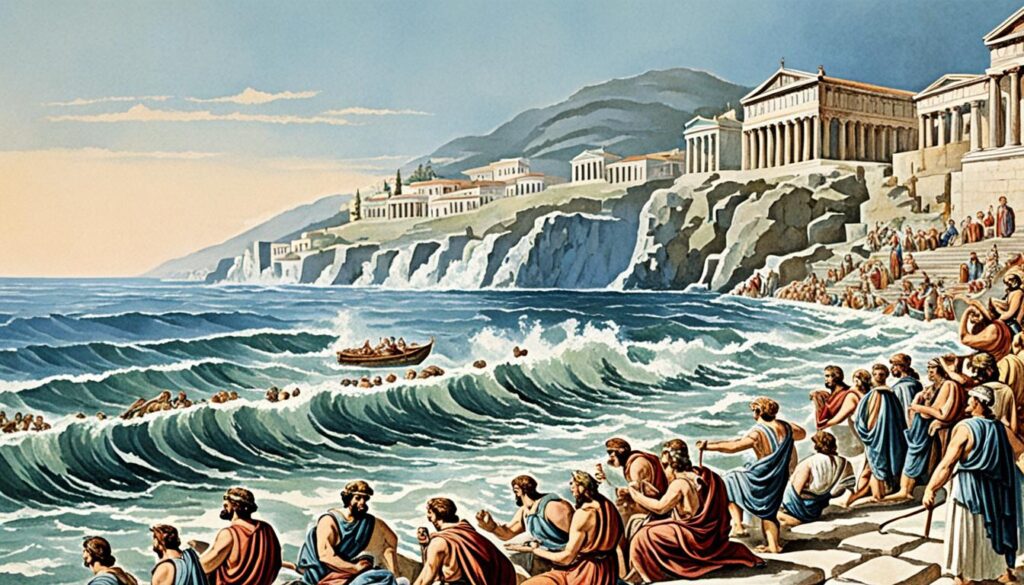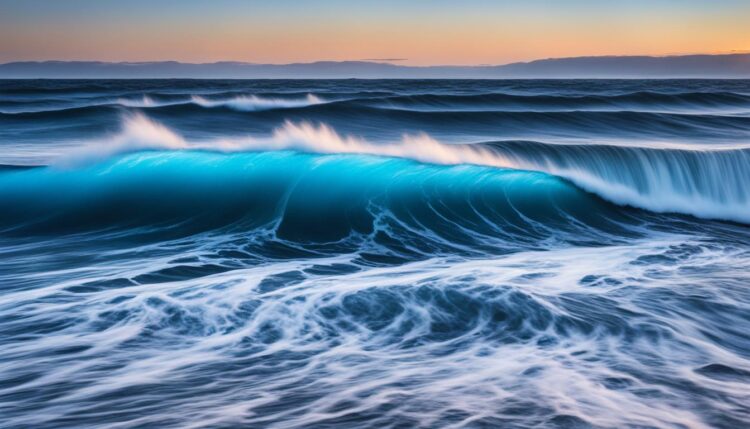The ocean’s rhythms are a captivating phenomenon that orchestrates the rise and fall of sea levels each day. This rhythmic dance, driven primarily by the moon’s gravitational forces, occurs in regular tidal cycles and significantly shapes our coastal landscapes.
Tides are more than just the ebb and flow of seawater; they are a powerful force impacting marine biodiversity and the intricate ecosystems within intertidal zones. Observing the tidal cycles reveals the beauty and complexity of this natural process and their importance in maintaining the health of our planet’s coastal landscapes.
Key Takeaways
- Ocean rhythms and tidal cycles are driven by the gravitational forces of the moon and sun.
- Tides occur in a predictable pattern, with two high tides and two low tides in a 24-hour period.
- Tidal movements significantly shape coastal landscapes and affect marine life.
- Intertidal zones harbor diverse ecosystems highly influenced by tidal changes.
- The potential of tidal power as a renewable energy source is promising but comes with challenges.
The Science Behind Tides
Understanding the ebb and flow of the tides requires a grasp on the cosmological forces shaping our oceans. At the heart of this intricate dance lies a gravitational interaction that intricately ties together the Earth, the moon, and the sun.
The Role of Gravitational Forces
The moon’s gravity is the primary driving force behind tidal phenomena. As the moon orbits the Earth, its gravitational pull causes ocean water to bulge out on the side of the Earth nearest to it, creating a high tide. A corresponding bulge occurs on the opposite side of the Earth due to inertial forces. This duality results in two high tides and two low tides within a 24-hour period.
The Tidal Context
Tides are caused by the gravitational pull between the Earth, moon, and sun, and their effects are observable as the rhythmic rise and fall of sea levels. While the moon’s gravity is the primary influence, the sun’s gravitational force also plays a significant, albeit secondary, role. The resulting sea level fluctuations impact coastal regions and marine ecosystems, creating a dynamic environment where both terrestrial and aquatic species must adapt to constant changes.
| Element | Primary Influence | Effect on Tides |
|---|---|---|
| Moon | Gravitational Pull | High and low tides every 12 hours |
| Sun | Gravitational Pull | Modulates the intensity of tides |
| Earth | Rotation | Daily tidal cycles |
This intricate gravitational interaction highlights the complex yet predictable nature of tidal phenomena, a celestial dance that dictates the rhythmic rise and fall of sea levels around the world.
Types of Tides
Tides are a complex, rhythmic rise and fall of Earth’s ocean levels, influenced by gravitational forces exerted by the moon and the sun. Understanding the different tidal patterns helps predict coastal changes and marine impacts.
Spring Tides
Spring tides occur when the moon and sun align, either during a new moon or a full moon. This alignment results in the highest high tides and the lowest low tides because the gravitational forces of the moon and the sun combine, pulling the ocean waters in the same direction. Such tidal patterns contribute to significant changes in shorelines and intertidal zones.
Neap Tides
In contrast, neap tides happen when the moon and sun are at right angles relative to Earth, usually during the first and third quarters of the lunar cycle. This positioning causes less extreme tidal conditions, meaning the difference between high and low tides is minimal. Neap tides are characterized by more moderate tidal patterns, which can be less impactful on coastal areas.
Diurnal Tides
Diurnal tides feature one high tide and one low tide each day. This single daily cycle results from the Earth’s rotation viewed from the North Pole and is influenced by the moon’s declination angle. The diurnal pattern can vary significantly around the globe, affecting both the height and the timing of the tides. Understanding these tides helps local communities manage coastal activities effectively.
| Type of Tide | Occurrence | Tidal Characteristics |
|---|---|---|
| Spring Tides | New Moon and Full Moon | Higher high tides, lower low tides |
| Neap Tides | First and Third Quarters of the Lunar Cycle | Moderate high and low tides |
| Diurnal Tides | Daily (in regions with one high and one low tide per day) | One high tide and one low tide per day |
Impact of Tides on Coastal Erosion
Tides play a pivotal role in coastal erosion, continuously reshaping shorelines through the process of wearing down and carrying away rocks, sand, and other materials. This geological activity is intricately influenced by the energy and frequency of tidal movements, which can lead to significant landscape transformations over time.
The impact of tides on coastal erosion is significant due to the varying energy levels generated by tidal forces. During high tides, the increased water level exerts more pressure on the coastline, exacerbating erosion by displacing sediments. Conversely, low tides expose more of the shore, leaving it vulnerable to wind and wave action, which also contributes to coastal erosion.
One of the most visible effects of tidal impact is sea level rise, which accelerates coastal erosion by allowing waves to reach further inland. This ongoing process changes the shoreline, causing fluctuations in the coastline’s position and morphology. The immediate outcomes include the loss of beach front, alterations in ecosystems, and even increased susceptibility to storm surges.
Shoreline changesare natural and inevitable, but understanding the tidal influences provides insightful perspectives on how to mitigate the adverse effects. Effective management strategies can be developed by monitoring tidal patterns and the corresponding erosion data. This approach helps in crafting sustainable solutions to preserve coastal environments and protect coastal communities.
| Tidal Impact | Effect on Coastal Erosion |
|---|---|
| High Tides | Increased pressure on the coastline, displacing sediments |
| Low Tides | Exposure of shoreline, increasing susceptibility to wind and wave action |
| Sea Level Rise | Accelerates erosion, allowing waves to penetrate further inland |
Ultimately, understanding the interplay between tides and coastal erosion helps in devising strategic measures to combat shoreline changes and protect vulnerable coastal regions. By recognizing the power of tidal forces, efforts can be directed towards fostering resilience in coastal zones.
Marine Ecosystems and Tides
The rhythmic dance of tides exerts a significant impact on marine ecosystems, particularly within intertidal zones. These areas, lying between high and low tides, serve as dynamic habitats teeming with biodiversity. The tidal influence shapes the life forms in these zones, challenging their ability to endure extreme environmental conditions.
Intertidal Zones
Intertidal zones are unique regions that experience alternating periods of submersion and exposure due to tidal influence. This continuous change creates a distinctive habitat that supports a rich array of marine organisms. These zones are critical for many species, contributing significantly to regional biodiversity. The zones are often categorized into high, middle, and low intertidal areas, each harboring different communities of marine life based on their location relative to the tides.
Adaptations of Marine Life
Marine organisms residing in intertidal zones exhibit remarkable environmental adaptation. These adaptations are essential for surviving the fluctuating conditions brought about by tides. Some key adaptations include:
- Shells and Exoskeletons: Many species possess hard shells or exoskeletons that protect them from desiccation and predation during low tides.
- Attachment Mechanisms: Organisms like barnacles and mussels have developed strong attachment mechanisms to withstand powerful wave action.
- Behavioral Adaptations: Certain species’ behaviors, such as burrowing or hiding during low tides, help them avoid extreme temperatures and salinity changes.
The combination of these adaptations ensures that the diverse marine life in intertidal zones continues to thrive despite the challenges presented by their ever-changing environment.
Tides and Ocean Currents
Understanding the intricate relationship between tides and ocean currents is essential for comprehending how water movement shapes our planet’s climatic systems and marine environments. Tidal forces, driven by the gravitational pull of the moon and the sun, play a critical role in creating and directing these currents, which in turn affect global climate patterns.
Ocean currents are continuous movements of seawater that circulate in various patterns across the globe. These currents are significantly influenced by tidal forces, which induce regular water movement due to their cyclical nature. By pushing and pulling ocean water, tides help steer the flow of these currents, contributing to the variability observed in different parts of the world.
The impact of tides on ocean currents can be observed through various dimensions, such as their influence on climatic systems and the distribution of marine life. For instance, the Gulf Stream, a powerful ocean current, is affected by tidal forces, which help regulate its flow and consequently impact weather patterns along the eastern coast of North America and Western Europe.
| Factor | Impact on Ocean Currents |
|---|---|
| Tidal Forces | Induce movement and direction of currents, affecting overall water movement. |
| Water Movement | Circulates nutrients and marine life, affecting ecosystems globally. |
| Climatic Systems | Regulate weather patterns and temperature distribution. |
In conclusion, tides and ocean currents are intrinsically linked, with tidal forces having a profound influence on the movement of seawater, climatic systems, and marine life. A deeper understanding of these interactions helps us appreciate the complex dynamics at play in our oceans.
Historical Significance of Tides
Tides have been a cornerstone in the evolution of maritime navigation and the progress of coastal civilizations. Ancient mariners relied heavily on their understanding of historical tides to guide their voyages, ensuring safe passage and successful journeys. This profound knowledge facilitated expansive ocean exploration, enabling humankind to chart new territories and engage in vibrant trade networks.

Furthermore, the influences of tides have been pivotal in coastal development. Settlements flourished along the shores, taking advantage of the tidal rhythms to optimize fishing, transportation, and trade. This symbiotic relationship between man and tide underscores the integral role that tidal knowledge played in shaping early societies and continues to inform contemporary coastal management practices.
The remarkable impact of tides is evident throughout maritime history, where meticulous attention to tidal cycles allowed for advancements in shipbuilding and navigation techniques. By understanding and harnessing the power of tides, explorers such as Christopher Columbus and Ferdinand Magellan achieved monumental feats in ocean exploration, transforming global interaction and economic development.
Harnessing Tidal Power
Tidal power is an immense and untapped resource that has begun to gain traction as a dependable source of renewable energy. This technology captures the kinetic energy from the movement of tides to generate electricity, offering a sustainable power option for the future.
Renewable Energy Source
Tidal energy is a form of hydropower that transforms the kinetic energy of ocean tides into electrical power. Unlike other renewable sources like solar and wind, tidal energy is highly predictable and consistent due to the natural cycles of the moon and Earth. This consistency makes it a reliable contributor to the grid, enhancing the overall stability of sustainable power.
Various countries, especially those with extensive coastlines like the United Kingdom and Canada, are investing in tidal energy projects. These initiatives are not only geared to mitigate the environmental impact of fossil fuels but also to harness the immense energy potential of ocean tides.
Potential and Challenges
While the potential for tidal energy is vast, several challenges must be overcome to maximize its benefits. One major concern is the environmental impact. Installation of tidal turbines and other infrastructure can affect marine life and coastal ecosystems. Studies are ongoing to develop methods that minimize these disruptions.
Technologically, the design, deployment, and maintenance of tidal energy systems are still in the early stages. High costs and technical complexities related to operating underwater are barriers that researchers and engineers are striving to address through innovation. Additionally, the economic feasibility of tidal energy projects demands significant initial investments, which can be a deterrent for widespread adoption.
| Aspect | Potential | Challenges |
|---|---|---|
| Tidal Energy Production | High predictability, renewable | Technological limitations, high costs |
| Environmental Impact | Low emissions, sustainable power | Effect on marine life, coastal changes |
The Dance of Waves vs. Tides
Waves and tides, though both pivotal to the marine environment, are inherently distinct in their origins and effects. Gravitational influences primarily drive tides, leading to the periodic rise and fall of water levels. Conversely, waves are generated by energy moving through water, with wind being the primary initiator.
These two oceanic phenomena play a crucial role in shaping marine dynamics. While wave energy impacts coastal regions through continuous movement, tidal changes affect marine ecosystems differently, causing cyclical exposure and submersion of intertidal zones.
To better grasp the nuances of wave energy and tides, let’s examine their key differences:
| Aspect | Waves | Tides |
|---|---|---|
| Primary Cause | Wind | Gravitational influences |
| Frequency | Continuous, variable | Predictable, cyclical |
| Effect on Marine Dynamics | Influences coastal shaping and erosion | Modulates marine and intertidal ecosystems |
| Energy Utilization | Wave energy can be harnessed for power | Tidal energy is used for renewable power |
In understanding these key differences, it becomes evident that both wave energy and tidal movements are integral to the broader context of oceanic phenomena. Mastering this knowledge is essential for effective coastal management and the sustainable utilization of marine resources.
Conclusion
As we draw to a close on our exploration of tidal patterns, it’s clear that understanding these natural phenomena is fundamental to both marine science and ocean stewardship. The intricate dance between gravitational forces and ocean movements not only shapes our coastlines but also plays a critical role in the lives of countless marine species. This ecological understanding allows us to appreciate the delicate balance within intertidal zones and the remarkable adaptations of marine life.
Moreover, acknowledging the historical and contemporary significance of tides—from their role in ancient navigation to their potential as a renewable energy source—reinforces the importance of continual research and innovation. As we enhance our knowledge, we also enhance our ability to manage and protect coastal regions, ensuring that ecosystems remain thriving and resilient.
In summary, the multifaceted study of tides offers valuable insights into both natural processes and human ingenuity. By fostering a deeper connection with our oceans, we take essential steps towards sustainable environmental practices and the preservation of our planet’s diverse marine habitats.











